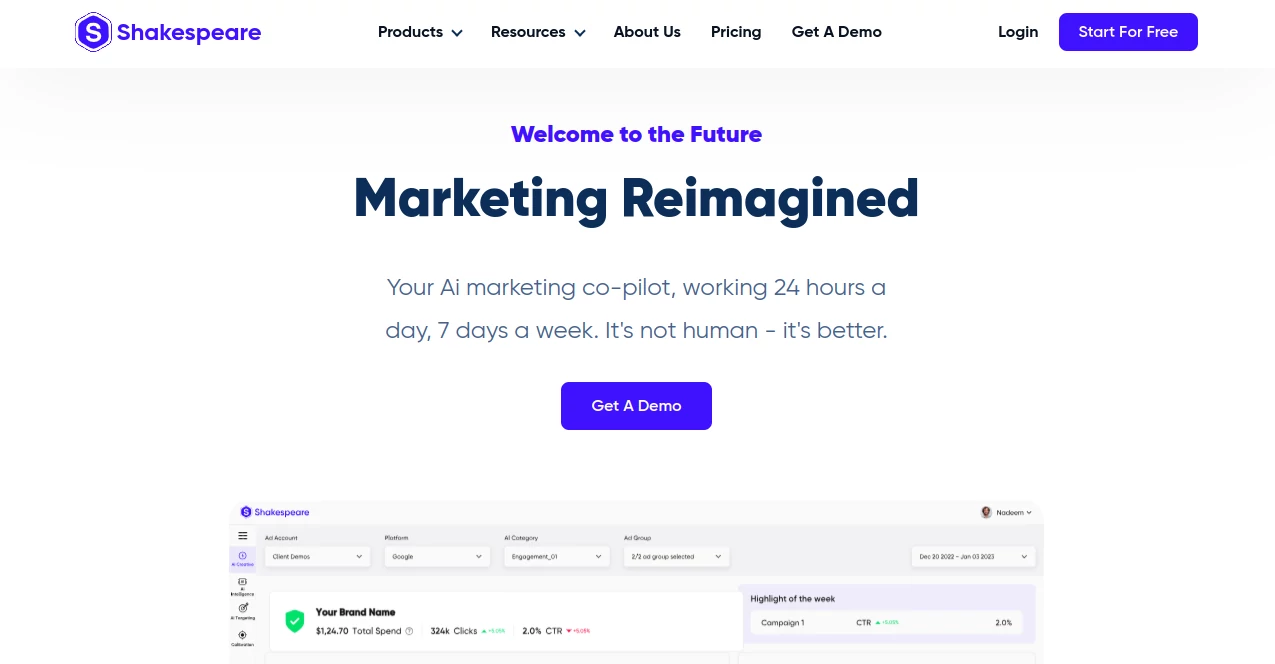Shakespeare AI
AI Co-Pilot for Smarter Marketing Moves

What is Shakespeare AI?
Shakespeare slips into the role of a tireless marketing sidekick, crunching numbers and spotting patterns to guide campaigns toward bigger wins. It pulls from your own data streams to suggest tweaks that feel sharp and timely, helping teams ditch the endless guesswork for steps that actually pay off. Marketers who've looped it into their routines often point to those quiet moments when a small shift in targeting turns a flat run into something that hums, all without pulling them from the bigger picture.
Introduction
Shakespeare grew out of the late-night huddles where ad pros swapped stories of campaigns that fizzled despite solid plans. A handful of data folks and strategists banded together to bottle that hindsight into something proactive, launching a tool that listens to your metrics and whispers back with real edges. It's caught on quick among mid-sized shops and agencies chasing efficiency, with users nodding to how it surfaces those overlooked pockets of potential that used to slip through cracks. The draw lies in its steady hand—always on, always pulling from what you've already got, turning scattered efforts into a flow that builds on itself without the usual starts and stutters.
Key Features
User Interface
The main screen unfolds like a command center, with feeds from your linked accounts rolling in clean and current, no hunt for buried stats. Tabs for audience breakdowns or creative tweaks hover right where your eyes land, and a central map lights up hot spots with a glance. It's the sort of setup that clicks after a quick walkthrough, letting you drill down or zoom out without menus getting in the way, and it holds steady even when feeds flood in from multiple spots.
Accuracy & Performance
When it flags a segment worth chasing, the picks line up tight with what the numbers say, often nailing shifts that lift pulls by double digits. It chews through live streams without a hitch, updating paths in the moment so you're never chasing yesterday's leads. Teams testing it out mention how it cuts through the fog better than manual scans, landing on moves that stick about eight out of ten times, leaving just enough wiggle for your gut to weigh in.
Capabilities
It scouts for crowd slices you might miss, then whips up tailored hooks—snappy lines or fresh visuals—that match without a full overhaul. Link up your tools, and it starts looping feedback to nudge spends toward what works, all while letting you dial in your brand's quirks for outputs that ring true. From one-off blasts to ongoing streams, it handles the weave across platforms, freeing you to layer in the human spark where it counts most.
Security & Privacy
Your feeds stay ringed by standard locks, with connections that only sip what they need and spit back nothing extra. It runs on the usual tight rails for handling shared info, giving you toggles to pull back or wipe traces when a run wraps. Folks in the know appreciate the no-nonsense approach, knowing their edge doesn't leak out while the system does its quiet work.
Use Cases
E-commerce crews use it to chase after quiet buyers, tweaking ads that nudge carts over the line without blanket blasts. Agencies feed in client mixes for cross-board tweaks, spotting overlaps that amp up shared wins. Seasonal runners lean on it for quick pivots, like swapping creatives mid-push to catch a fresh wave. Even small ops with tight budgets find it stretches their reach, turning slim data into smart plays that punch above weight.
Pros and Cons
Pros:
- Pulls from your own pots for suggestions that fit like they were yours.
- Live loops mean you're always a step ahead of the drift.
- Hooks into everyday tools without a big lift.
- Boosts the bottom line on pulls and spends without extra hands.
Cons:
- Shines brightest with meaty data—light starters might need a warmup.
- Demo credits cap the first taste, nudging toward deeper dips.
- Brand fine-tunes take a round or two to settle just so.
Pricing Plans
You start with a free peek via the demo signup, tossing in ten thousand credits to run a full test without a dime down. From there, plans shape up around your scale—basic runs low for steady shops, stepping to mid for teams juggling multiples, and custom chats for outfits chasing tailored fits. It's built to grow with you, with no long locks and easy steps up as your needs nudge wider.
How to Use Shakespeare
Link your accounts through the setup wizard—it grabs the essentials in a few taps, then lets you poke at the dashboard for a feel. Dial in your brand notes to shape the outputs, watch it flag a crowd or draft a hook, and greenlight the tweaks that click. Let it hum in the background for ongoing nudges, or pull reports to share with the crew, circling back weekly to refine based on what landed.
Comparison with Similar Tools
Where basic trackers just log what happened, Shakespeare leans forward with active nudges, though those might suit pure number-crunchers better. Against full agency suites, it's nimbler on the daily grind, skipping the bloat for focused lifts, but could miss the hand-holding for total greenhorns. It edges out for shops wanting that data-to-decision zip, blending scale with smarts where others lag or layer on too thick.
Conclusion
Shakespeare quiets the scramble of marketing guesswork, handing you a steady compass built from your own trail. It turns the what-ifs into watch-this, letting teams chase bigger plays without the burnout. As crowds keep splintering and speeds crank up, this co-pilot stays the course, proving that the sharpest edges come from tools that listen close and move quick.
Frequently Asked Questions (FAQ)
What gets it up and running fast?
A quick link to your ad spots and CRMs, then you're scanning in under an hour.
How hands-off is the daily bit?
Pretty light—set your bounds, and it runs loops while you chase the next big swing.
Does it play nice with my stack?
Snaps into most major ad and social hubs, plus CRM ties for smooth flows.
What's the win on numbers?
Users see lifts in conversions and spends, often doubling up on what they chased.
Can I test without committing?
The demo hands over credits to run real rounds, no strings till you're hooked.
AI Advertising Assistant , AI Analytics Assistant , AI Ad Creative Assistant , AI Marketing Plan Generator .
These classifications represent its core capabilities and areas of application. For related tools, explore the linked categories above.
Shakespeare AI details
This tool is no longer available on submitaitools.org; find alternatives on Alternative to Shakespeare AI.
Pricing
- Free
Apps
- Web Tools

















